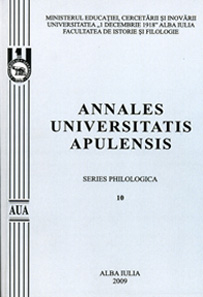SUR LE TRANSFERT DE PROCÉDÉS ENTRE LA LITTÉRATURE
ET LA PSYCHOLOGIE COGNITIVE DANS L’EXPLORATION DES RÊVES
ON THE TRANSFER OF PROCESSES BETWEEN LITERATURE AND COGNITIVE PSYCHOLOGY IN THE EXPLORATION OF DREAMS
Author(s): Cristiana Bulgaru-TeşculăSubject(s): Literary Texts
Published by: Universitatea »1 Decembrie 1918« Alba Iulia
Keywords: dream structure; sequence linking; logical relations; bizarre phenomena; visual representation
Summary/Abstract: This paper attempts to present two complementary exploratory analyses of dreams which show interest for its signifier and seem to exchange certain procedures: Les Songes et les Sorts (1991), the collected dream transcripts of M. Yourcenar – its introduction details the author’s opinions on dreams, especially the analogical construction of dreams – the literary construction, and Rêve et cognition (1999), the book by Genevan professor Jaques Montagero, who also parallels dreams and literature, discussing the structure and characteristics of dreams. M. Yourcenar, dreamer and dream analyst, communicates her views of ‘the obscure process of dreaming’ (the introduction to Songes) by means of a subjective and omissive story of the phenomenon. Overlapping the construct of the imaginary dream with the literary one is based, in her case, on two ideas of romantic origins – the dreamer-poet analogy, which makes the dream a jigsaw of images similar to the jigsaw of rhyme and words in a poem, and the dreamer-Narcisus analogy, which makes the dream image, as well as the literary image, a reflecting surface, correcting, upsetting or distorting the source material. Thus, the ‘three ways of dreams’ become ‘the three ways of writing’ and involve the outside as well as the inner world of the one who observes reality. (Carmen Ana Pont). Moreover, almost all statements about various aspects of dreams become starting points for further reflection on the writing of dreams, about the difficulty of wording the richness of dream worlds, about the need to find a new language, nuanced enough to describe visual imagery. The transcribing procedure Yourcenar proposes is closely related to prose poetry and seems to fit the 22 ‘poetical and hallucinating’ dreams from the volume. Mysterious and coherent structures but lacking conclusion, solemn and strongly emotional, these dreams are made of a privileged texture, that of ‘the few pathetic memories of our lives’ (introduction to Songes); they oppose oblivion and have exceptional visual quality. Remarkable with this author is the fact that the discourse on the structure, features, sources and texture of dreams is a strategy meant to direct the reader’s attention to observing the dream and not interpreting it, which would often be indiscrete or oversimplifying just as psychoanalysis is, whose symbolic representations are, she believes, almost entirely sexual. An appropriate reading, fulfilling the expectations formulated in the introduction to Songes could be one of cognitive psychology origins, based on close observation of dream content and on highlighting their originality compared to perception and day logic. Still, the method suggested by Jaques Montangero does not ignore the problem of interpretation, but it focuses on the creative attribute of dreams which means constructing not replicating. This creative attribute is to be found in the way dream sequences are linked according to the logic of what is plausible.
Journal: Annales Universitatis Apulensis. Series Philologica
- Issue Year: 11/2010
- Issue No: 3
- Page Range: 318-331
- Page Count: 14
- Language: French

